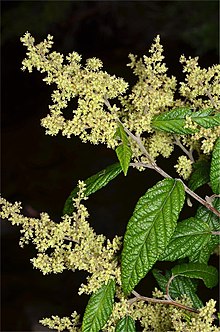Pomaderris aspera
| Hazel pomaderris | |
|---|---|

| |
| Pomaderris aspera near Gibraltar Falls | |
| Scientific classification | |
| Kingdom: | Plantae |
| Clade: | Tracheophytes |
| Clade: | Angiosperms |
| Clade: | Eudicots |
| Clade: | Rosids |
| Order: | Rosales |
| Family: | Rhamnaceae |
| Genus: | Pomaderris |
| Species: | P. aspera |
| Binomial name | |
| Pomaderris aspera | |
| Synonyms[1] | |
|
Pomaderris mollis Colenso | |
Pomaderris aspera, commonly known as hazel pomaderris,[2] is a species of flowering plant in the family Rhamnaceae and is endemic to south-eastern Australia. It is a shrub or small tree with elliptic to lance-shaped or egg-shaped leaves and greenish-yellow flowers.
Description
Pomaderris aspera is a shrub or small tree that typically grows to a height of 2–20 m (6 ft 7 in – 65 ft 7 in), and has dark brown, fairly smooth bark with some fissures and longitudinal irregularities. The branchlets are covered with rust-coloured, star-shaped hairs when young. The leaves are elliptic to lance-shaped or egg-shaped, 40–120 mm (1.6–4.7 in) long and 20–60 mm (0.79–2.36 in) wide with more or less toothed edges. The upper surface of the leaves is dark green and impressed above the veins, the lower surface whitish with rust-coloured hairs on the veins. The flowers are borne in loose panicles 80–250 mm (3.1–9.8 in) long and are cream-coloured to greenish-yellow, each flower on a pedicel 1–3.5 mm (0.039–0.138 in) long. The sepals are 1.5–2.0 mm (0.059–0.079 in) long and there are no petals. Flowering occurs in October and November and the fruit is a dark brown, glabrous capsule 3 mm (0.12 in) in diameter containing a single bone-coloured seed.[2][3][4]
Taxonomy
Hazel pomaderris was first formally described in 1825 by Augustin Pyramus de Candolle from an unpublished description by Franz Sieber. De Candolle's description was published in his Prodromus Systematis Naturalis Regni Vegetabilis.[5][6] The specific epithet (aspera) means "rough".[7]
Distribution and habitat
Pomaderris aspera grows in wet forest, especially near streams in gullies and mainly occurs south from Barrington Tops in New South Wales and the Australian Capital Territory, with scattered individuals in northern New South Wales and as far north as Bunya Mountains National Park in Queensland. It is common in southern and eastern Victoria, less so in northern Tasmania and may also occur in South Australia. The species has also been naturalised in New Zealand.[2][3][4][8][9]
References
- ^ a b "Pomaderris aspera". Australian Plant Census. Retrieved 2 January 2022.
- ^ a b c Walsh, Neville G. "Pomaderris aspera". Royal Botanic Gardens, Victoria. Retrieved 2 January 2022.
- ^ a b Harden, Gwen J. "Pomaderris aspera". Royal Botanic Garden Sydney. Retrieved 2 January 2022.
- ^ a b Floyd, A. G. (2008). Rainforest Trees of Mainland South-eastern Australia (2nd, Revised ed.). Lismore, New South Wales: Terania Rainforest Publishing. p. 325. ISBN 978-0-958943-67-3. Retrieved 2010-05-24.
- ^ "Pomaderris aspera". Australian Plant Name Index. Retrieved 2 January 2022.
- ^ de Candolle, Augustin P. (1825). Prodromus Systematis Naturalis Regni Vegetabilis. Vol. 2. Paris. p. 33. Retrieved 2 January 2022.
- ^ Francis Aubie Sharr (2019). Western Australian Plant Names and their Meanings. Kardinya, Western Australia: Four Gables Press. p. 138. ISBN 9780958034180.
- ^ Jordan, Greg. "Pomaderris aspera". University of Tasmania. Retrieved 2 January 2022.
- ^ "Pomaderris aspera". New Zealand Plant Conservation Network. Retrieved 2 January 2022.
